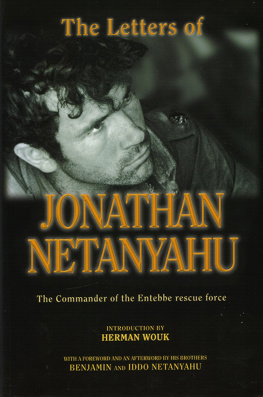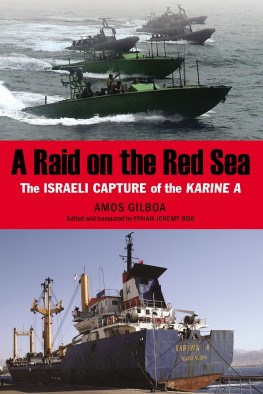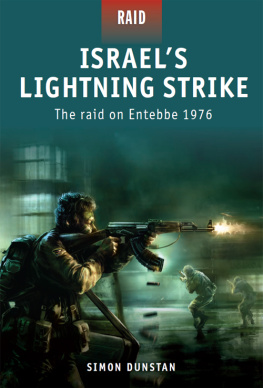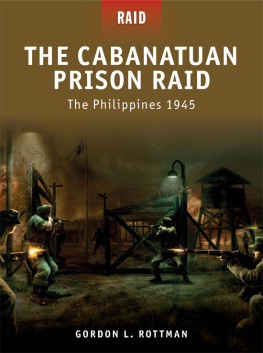Copyright Iddo Netanyahu
Jerusalem 2002/5762
All rights reserved. No part of this publication may be translated, reproduced, stored in a retrieval system or transmitted, in any form or by any means, electronic, mechanical, photocopying, recording or otherwise, without express written permission from the publishers.
Typesetting: Marzel A.S. Jerusalem
Cover Design: Studio Paz, Jerusalem
Translated by Yoram Hazoni
7 9 8
| Gefen Publishing House | Gefen Books |
| POB 36004, Jerusalem 91360, Israel | 12 New Street Hewlett, NY 11557, USA |
| 972-2-538-0247 | 516-295-2805 |
www.israelbooks.com
| Printed in Israel | Send for our free catalogue |
ISBN 965-229-283-4 (alk. paper)
Library of Congress Cataloging-in-Publication Data:
Netanyahu, Iddo
[Ha-kerav ha-aharon shel Yoni. English]
Yoni s last battle / Iddo Netanyahu
Includes bibliographical references
1. Netanyahu, Yonatan, 1946-1976.
2. Entebbe Airport Raid, 1976,,History.
3. Israel,,Armed Forces,,Officers,,Biography. I. Title.
DS119.7.N4413 2001 956.9405 092,,dc21 CIP Number: 2001040950
Testimonial Statements about Yonis Last Battle
The time I served in the General Staff Reconnaissance Unit of the Israeli army (generally known as the Unit) formed an unforgettable period in my life, and one of its high points was the rescue mission to Entebbe, renamed Operation Jonathan.
Our unit was given the task of freeing 105 hostages who were held by terrorists at the old terminal of Entebbe Airport in Uganda. The Units men did their utmost in preparing and carrying out the mission. Their commander was Lt.-Col. Jonathan (Yoni) Netanyahu.
From the moment the rescue mission was assigned to the Unit, Yoni was, of course, the man who led his staff in the preparations. From the start, he laid out the Units plan of operation, oversaw the preliminaries, gave briefings to all the Units participants in the mission and, above all, imbued us and others involved in the operation with the faith that the task could be successfully accomplished. All this he carried out in a determined and inspiring fashion.
In the years since, I have read everything published about the Entebbe mission. The book before you by Yonis brother, Iddo Netanyahu is a landmark of the greatest importance in chronicling the operation. For the first time, as a result of definitive research, it provides a true picture of the General Staff Reconnaissance Units actions from the moment it began preparing for the operation, through the successful assault on the old terminal at Entebbe, in which Yoni was killed, to the return to Israel of the troops and the hostages they had freed.
This book tells our story in a manner that is graceful, stirring, and most important, completely faithful to the facts.
Lt.-Col. (Res.) Yohai Brenner
Head of Staff of the General Staff Reconnaissance Unit
(Sayeret Matkal) at the time of the Entebbe operation
Operation Jonathan was one of the most spectacular airborne military operations ever. It was carried out by the unique combination of a small, brave, and determined crack commando unit and a young, professional C-130 Hercules squadron. Both the Unit and the squadron were assigned to the mission on extremely short notice. Nevertheless, this combined task force, assisted by additional elements, successfully executed its complex mission, which was fraught with grave dangers.
This book describes the operation, named after Jonathan Netanyahu, the commander of the rescue force, who lost his life during the raid. Besides being a gripping narrative, it offers a faithful account of the events. The author, brother of the late commander and himself a former member of the Unit, managed, through meticulous research, to reconstruct the great drama that moved and inspired millions of people around the world.
Brig. Gen. (Res.) Joshua Shani
Israel Air Force
Lead pilot of the Entebbe operation
Authors Note
The present work is based on more than seventy taped interviews, mostly with participants of the raid at Entebbe. They included the organizers, planners and fighters assigned to the mission. I also examined the written reports of the squad leaders from the Unit (General Staff Reconnaissance Unit, or Sayeret Matkal), describing various phases of the action. Additionally, I utilized transcripts of interviews conducted in July 1976 by Israel Defence Forces Radio researcher Dani Veseli with three of the Units participants in the raid, as well as taped statements made in July 1986 during a commemorative meeting of the Entebbe operation, by several reserve members of the Unit who described the raid and the preparations that led to it. Of assistance also were materials culled from a few broadcasts and published accounts, which helped me complete the overall picture.
Because the identities of some of the Units members remain classified, I have referred to them by their first names alone.
Unless otherwise indicated, the quotes included are from taped interviews.
Foreword
A few minutes past midnight on July 4, 1976, a band of Israeli commandos drove along the silent runways of Entebbe Airport in Uganda. The Hercules transport plane that had brought them receded from view, and before them stretched dark asphalt, hedged on either side by tall African grass. The lead car of the tiny convoy was a black Mercedes waving a Ugandan flag. Close behind it were two Land Rover jeeps. All three cars bore Ugandan license plates made of cardboard and drove with their lights on to add to their innocent appearance.
Their target the old terminal building at the east end of the airfield was drawing closer. In less than a minute, the men in the three cars would carry out one of the most spectacular and successful commando missions in military annals the rescue of 105 hostages, held there at gunpoint for nearly a week by both the terrorists who had hijacked their plane and the Ugandan army.
Thirty-odd soldiers comprised the assault force. All belonged to the General Staff Reconnaissance Unit of the Israeli army (known as the Unit or Sayeret Matkal). Their commander, who rode in the front seat of the Mercedes and who, like his soldiers, wore Ugandan camouflage fatigues, was my brother, Lt.-Col. Jonathan (Yoni) Netanyahu. At 30, he was the oldest man in the group.
Several hours later, a phone call from an officer I knew from my own service in the same unit woke me up in my home in Jerusalem. I was still assigned to the Unit as a member of the army reserves, and wondered what it was that he wanted from me at that early hour of the morning. For the time being, stay at home, he said. Once all this is over, you can go back to your usual routine. Only half awake, I vaguely remembered a phone call earlier in the week from the Unit, following the hijacking of the Air France plane to Uganda, telling me that I should be ready for call-up at any moment if I was needed. By the way, can you give me Bibis phone number in Boston? added the officer who had woken me up, referring to my other brother, Benjamin Netanyahu, who was then studying in the United States.
I gave him Bibis number and put the phone down. I had no inkling that a rescue mission had taken place, and even less that anything had gone awry. But along with the rest of the country, I soon found out about the operation, once the first report was broadcast on the radio and everyone in Israel began phoning one another to pass on the news. It didnt take long before I got a call from Bibi. He was overjoyed at the news of the raid and its success, and asked if Id heard yet from Yoni there was no question, of course, that Yoni and his unit were at the center of the action.











